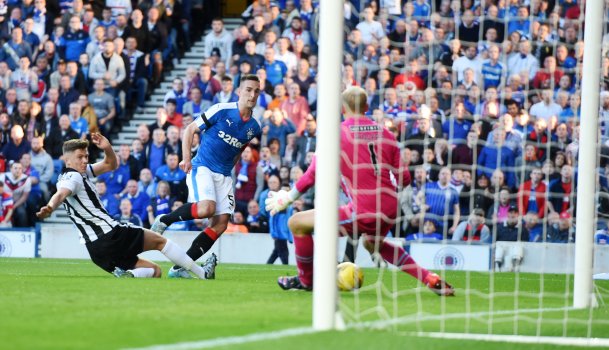Craig Cairns takes his latest tactical look at the SPFL, focusing on some of the best team goals scored this season.
Lee Wallace v St Mirren
There are many Rangers goals which could fit into this description, especially back nearer the start of the season when the Gers were at their free-flowing best from week to week. One goal from that time which stands out is Lee Wallace’s second strike versus St Mirren on the opening day of the Ladbrokes Championship season.
Though Mark Warburton’s side was still at an embryonic stage, it put down a marker for the style and system he was looking to implement throughout the season. In this match, his 4-1-2-3 included two natural wingers either side of Martyn Waghorn but in subsequent games this changed to include Kenny Miller in place of one of those wingers.
Wallace’s goal shows every cog of this well-oiled machine in full flow. The first thing to note is the amount of attackers Rangers have pressed up against the St Mirren defence. Waghorn drops outside the box to link with those around him and the central midfielders push high up to support him. They, along with the wingers, move into the spaces created by the movement, overwhelming the opposition defence.
One player who has thrived in this system is Jason Holt. The midfielder joined Rangers from Hearts and seems to have found the perfect system for his abilities. As one of the two just ahead of the defensive midfielder, Holt is tidy in possession and is asked to find space between the lines as well as to arrive in the box to finish off moves.
It is his clever though ball that finds the surging run of Wallace, which marks the key feature of the Rangers system. Their full-backs attack more aggressively than most others, especially given that they often do it in tandem. As the season has progressed they have learned to temper their runs relative to that of the other and have totalled 24 goals between them.
Miles Storey v Ross County
Slick, possession football was what John Hughes was known for during his time as Falkirk manager and he has come to be known for a similar brand at Inverness, albeit in a slightly more pragmatic fashion.
He has done so through improving players already at the club while continuing Terry Butcher’s knack for rummaging around the lower leagues in England and fostering a sense of togetherness in their relatively remote setting.
Inverness may have failed to reach expectations this season – they did set the bar extremely high after winning the 2015 Scottish Cup – but they did so in the wake of losing several keys players from that squad.
Nevertheless, Hughes has stuck to his philosophy, instructing his centre-backs to be brave on the ball and to resist launching it forward and playing percentages. For much of the season he has played without wingers, instead packing the midfield area with the likes of deep-lying playmaker Greg Tansey, who is aided by the emerging Liam Polworth and the increasingly attacking Ross Draper.
It was a poor start to the season for Caley Thistle, who lacked any real potency in attack and, as a consequence, failed to win any of their first six league matches. Then Hughes added a striker with the perfect skill set for his system. Miles Storey’s pace and movement off the ball made him the perfect spearhead to a side that likes to work the ball forward and slip in through balls.
Storey finished the season with 13 goals, though his one against Ross County in October stands out as it brings all of the above elements together. Inverness pass the ball across their backline before a midfielder drops into space to take possession. There’s then a neat interchange between David Raven, Andrea Mbuyi-Mutombo and Polworth before Storey – who has instinctively sniffed out space in the area – is teed up for the finish.
Alex Schalk v Hibernian
Last-minute, cup-winning goals are special no matter the extraneous details. Alex Schalk’s winning goal in the League Cup Final against Hibernian, however, was the culmination of a tactically intriguing encounter. Jim McIntyre shocked everyone with his lopsided 3-5-2 formation, which allowed him to match the Hibernian diamond man for man while retaining a strike partnership.
Ricky Foster started as a defensive-minded left wing-back, with Michael Gardyne fielded as more of a winger on the opposite side. Gardyne not only prevented Lewis Stevenson from making forward runs, he terrorised the Hibernian defence when he got on the ball, including giving his side a first-half lead.
Hibernian equalised before the break and were piling on the pressure in the second half, prompting McIntyre to make two changes. Brian Graham came on to play just off Schalk and Jonathan Franks was brought on to replace Foster. The changes meant that the County defence now had a target man to aim crosses at, as well as someone to relieve pressure when they were penned in. It also gave them a quick, attacking presence on either wing when launching counter-attacks.
In the dying seconds, with Hibs pushing men forward in the hope of finding a winner, County won the ball and moved it forward quickly. Graham picked up the ball around the centre circle before finding Schalk, who fed Gardyne. The unyielding winger ran at the Hibs defence one last time before aiming a cross at Graham – who had already come very close to scoring twice – at the back post.
Even though the ball did not reach its intended target, it forced Liam Fontaine into setting up Schalk for a tap-in. The finish may not be your classic cup-winning strike, but it came at the end of tactically brave decision-making from McIntyre, involved a game-changing substitution, and came from their trusted source of putting crosses into the box.





.png)












